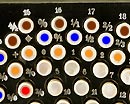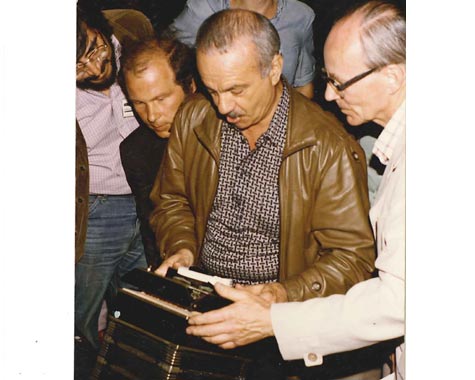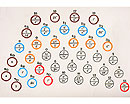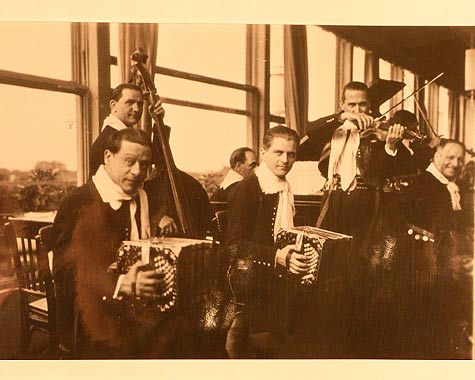
(Tango-) Bandonion
Rheinisches System, 142 tones
bisonoric
(Collection Oriwohl, Nr. 129)
Manufacture: Co. Alfred Arnold (Carlsfeld, founded 1911), as of 1929, (H: 23cm; T: 25cm)
The overall sound of this type is considered the benchmark in tango music and is still sought after even today - especially in Argentina.
These instruments also bear witness to the high quality of the Alfred Arnold company, for example with the even weighting of the keystroke. The model is one of the most built Bandonions, the majority of which were exported to Argentina where they is used style-defining of tango music.


Left manual with 33 keys for 66 tones:
The musicians' wishes led to more and more tones. The instrument has a total of 142.
However, this number was not foreseeable when the first concertinas were built. An early step from the concertina 56 tones (white keys 1-13) to 64 tones (+red keys). At intervals of several years followed e.g. 88 tones(+orange), 108 tones (+blue) and 142 tones (+brown).
In 1846-68 the bandonion was expanded from 56 to 130 tones. (Graf: p. 80)
The new notes were arranged around the key block of the concertina (white) according to the favourable fingering.


Right manual with 38 keys for 76 tones:
Since the tone disposition of the keys does not follow an externally logical system and can only be mastered by memorisation, a numbering system should be offer some help.
The Konzertina was numbered 0-14 in a logical sequence. The extensions, however, could not logically continue this, which is why new symbol series were invented for each extension.
Behind the partly cryptic symbols, the only thing hiding is the manufacturer's effort to make the newly added keys as easy to find as possible for its customers.


The numbering 1-14 was followed by a slash scheme:
2/0 e.g. indicates that the key is beyond zero, and 1/2 e.g. between 1 and 2. To the left of the zero a cross was inserted, so that the key between the cross and zero became the 'cross zero'. From 108 keys onwards, the symbols were changed again.
And since the last extension (brown) was probably lacking further ideas, for the outermost 4 keys were again connected to the 14, which was once the end many years ago.
Not only the tone assignment, but also the numbering system follows no continuous logic.


The bisonoric bandonion is therefore not an instrument conceived as a whole, but has been gradually expanded over the decades. The same applies to the various Konzertinas.
In the picture, Astor Piazzolla "investigates" what is hidden behind the cryptic characters on his keyboard... As a professional musician for many years, he naturally had this in mind and didn't need any auxiliary signs in order to play the Tango Nuevo.
Piazzolla (1921-92) further developed the Argentinian tango through his compositions and with his unconventional tango, sparked off a tango enthusiasm in Europe from the 1980s onwards. (On the right Karl Oriwohl)


Right side:
Tone assignment of the keys. The colour-coded extensions from 56 tones to 64 (+red), 88 (+orange), 108 (+blue) and 142 tones (+brown) shows the respective chromatic extensions of the tonal stock and new repeat tones, when tones became available for both directions of the bellows.
In addition, it can be seen that 'bisonoric' refers only to a majority of the keys, because among the total of 70 keys there are also 12 unisonoric. The last two extensions of the right side (7 keys) are the ones with the same tone.


Left side:
Tone assignment of the keys
Once introduced, each extension level had to be maintained, even if a more advantageous tone disposition might have presented itself later.
A subsequent change in the system would have devalued the repertoire of the players and the literature. Hardly anyone would buy a new instrument with additional tones, if its tone assignment no longer corresponded to the one already learned. A clear case of path dependency.


Due to the keyboard system, playing according to sheet music requires an intensive occupation with the instrument and music theory. Scales and chord fingerings are different for each key and for push and pull. Depending on the musical progression, the direction of the bellows is usually chosen according the most favourable direction of fingering.
"The only German bandonion with the brand name A.A. Reg.77037" reads the stamp imprint on this instrument made for export. All bandonions played in Argentina were, almost without exception, made in Germany manufactured.


A and AA at a glance. The latter was introduced in 1929 as a new trademark of the company Alfred Arnold and is today an indication of the time of manufacture of an instrument. Before 1929 a simple A, like the instruments of the company Ernst Louis Arnold, who introduced the abbreviation E.L.A. for its products in 1925.
Ernst Louis Arnold (1838-1910) had studied under Carl Zimmerann (1817-98) in Carlsfeld and took over his Konzertina factory in 1864.
Alfred Arnold (1878-1933) was his youngest son, who also founded his own company in Carlsfeld in 1911. Both companies were forcibly expropriated in the GDR.


The band Solen from Argentina as guests on the roof terrace of the Hotel Eden in Berlin around 1930. As real Argentinians of course with 142-tone Bandonion with Rhenish system. You will hardly find another model in Argentina.
Whereas in Germany from the end of the 1920s onwards the piano accordion entered the market, the export to Argentina gave some manufacturers full order books one last time, before the dissolution of the bandonion movement, world war, expropriation and changing leisure behaviour with radio and television brought about the decline of an production branch.
